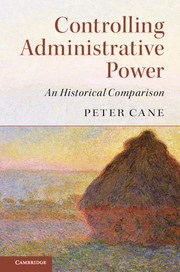Book contents
- Frontmatter
- Dedication
- Contents
- Preface
- Table of cases
- Table of legislation
- 1 Introduction: concepts and methodology
- 2 The English system of government
- 3 The US system of government
- 4 The Australian system of government
- 5 The development and institutional structure of control regimes
- 6 Administrative interpretation
- 7 Administrative fact-finding and policy-making
- 8 Administrative rule-making
- 9 Administrative adjudication
- 10 Private law controls
- 11 Controlling information
- 12 The New PublicManagement
- 13 Controlling the controllers
- 14 Concluding reflections on methodology and themes
- Bibliography
- Index
12 - The New PublicManagement
Published online by Cambridge University Press: 05 March 2016
- Frontmatter
- Dedication
- Contents
- Preface
- Table of cases
- Table of legislation
- 1 Introduction: concepts and methodology
- 2 The English system of government
- 3 The US system of government
- 4 The Australian system of government
- 5 The development and institutional structure of control regimes
- 6 Administrative interpretation
- 7 Administrative fact-finding and policy-making
- 8 Administrative rule-making
- 9 Administrative adjudication
- 10 Private law controls
- 11 Controlling information
- 12 The New PublicManagement
- 13 Controlling the controllers
- 14 Concluding reflections on methodology and themes
- Bibliography
- Index
Summary
Introduction
In this book so far, the focus in each of our jurisdictions has been on the layer of government with the most extensive geographical reach: central government in England and the federal government in the United States and Australia. Relatively little attention has been paid to other levels (or ‘layers’) of government, such as State government in the US and Australia, and devolved and local government in England. Layering has always been a characteristic of governmental arrangements in our three systems. However, developments over the past four decades are commonly understood to have made government even more layered than in the past.
Imagining the layers of government arranged vertically, two types of layering may be seen to have characterised developments in recent decades: downwards and upwards. The English system provides clear illustrations of upwards layering. These have resulted primarily from Britain's membership of the European Communities (now the European Union) in 1972, and its accession to the European Convention on Human Rights (ECHR), which was given greater domestic force by the Human Rights Act 1998 (HRA). Notable examples of downwards layering include creation of executive and independent regulatory agencies in England and Australia, and outsourcing of the provision of governmental services and the performance of governmental functions to ‘non-governmental institutions’ or ‘non-state actors’. In the US, this latter type of downwards layering is commonly referred to as ‘third-party government’. In the attractive language of ‘tools of government’, the paradigm of traditional governmental activity may be dubbed ‘direct’ in the sense that traditional governmental actors not only decide what to do and how to do it (‘policy-making’) but also undertake the tasks of funding and implementing the chosen courses of action. In the paradigm control regime, traditional government activity is scrutinised and controlled by traditional governmental actors. In the world of third-party government, non-governmental actors may be involved in any of these activities: policy-making, funding, implementation and control (the last often, in this context, referred to as ‘regulation’).
The concept of third-party government assumes a distinction between public and private. Governmental institutions are understood to be public and non-governmental institutions are understood to be private. In terms of this distinction, third-party government involves private entities engaging in public (or ‘collective’) action and activity.
- Type
- Chapter
- Information
- Controlling Administrative PowerAn Historical Comparison, pp. 437 - 474Publisher: Cambridge University PressPrint publication year: 2016

